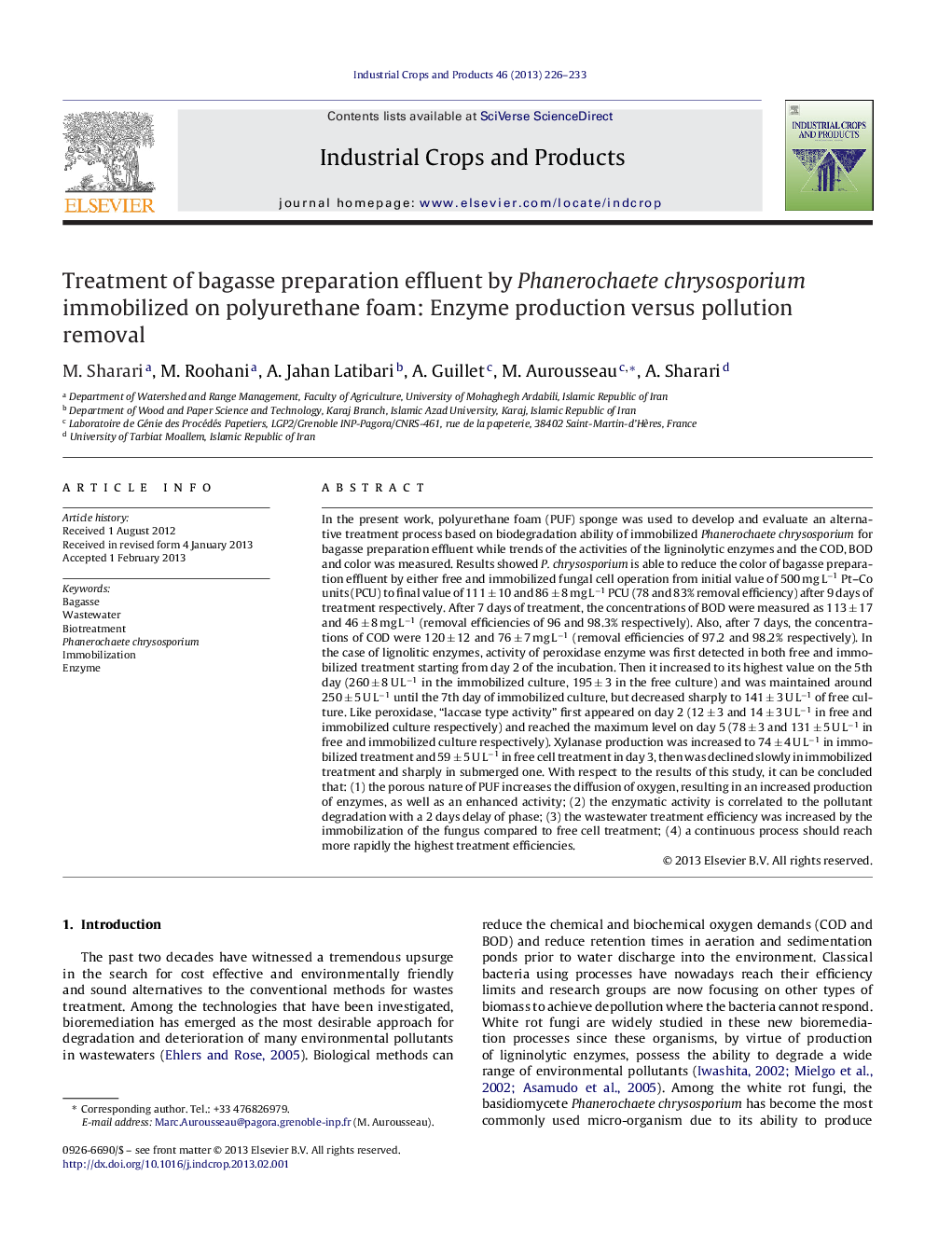| کد مقاله | کد نشریه | سال انتشار | مقاله انگلیسی | نسخه تمام متن |
|---|---|---|---|---|
| 4513849 | 1624863 | 2013 | 8 صفحه PDF | دانلود رایگان |

In the present work, polyurethane foam (PUF) sponge was used to develop and evaluate an alternative treatment process based on biodegradation ability of immobilized Phanerochaete chrysosporium for bagasse preparation effluent while trends of the activities of the ligninolytic enzymes and the COD, BOD and color was measured. Results showed P. chrysosporium is able to reduce the color of bagasse preparation effluent by either free and immobilized fungal cell operation from initial value of 500 mg L−1 Pt–Co units (PCU) to final value of 111 ± 10 and 86 ± 8 mg L−1 PCU (78 and 83% removal efficiency) after 9 days of treatment respectively. After 7 days of treatment, the concentrations of BOD were measured as 113 ± 17 and 46 ± 8 mg L−1 (removal efficiencies of 96 and 98.3% respectively). Also, after 7 days, the concentrations of COD were 120 ± 12 and 76 ± 7 mg L−1 (removal efficiencies of 97.2 and 98.2% respectively). In the case of lignolitic enzymes, activity of peroxidase enzyme was first detected in both free and immobilized treatment starting from day 2 of the incubation. Then it increased to its highest value on the 5th day (260 ± 8 U L−1 in the immobilized culture, 195 ± 3 in the free culture) and was maintained around 250 ± 5 U L−1 until the 7th day of immobilized culture, but decreased sharply to 141 ± 3 U L−1 of free culture. Like peroxidase, “laccase type activity” first appeared on day 2 (12 ± 3 and 14 ± 3 U L−1 in free and immobilized culture respectively) and reached the maximum level on day 5 (78 ± 3 and 131 ± 5 U L−1 in free and immobilized culture respectively). Xylanase production was increased to 74 ± 4 U L−1 in immobilized treatment and 59 ± 5 U L−1 in free cell treatment in day 3, then was declined slowly in immobilized treatment and sharply in submerged one. With respect to the results of this study, it can be concluded that: (1) the porous nature of PUF increases the diffusion of oxygen, resulting in an increased production of enzymes, as well as an enhanced activity; (2) the enzymatic activity is correlated to the pollutant degradation with a 2 days delay of phase; (3) the wastewater treatment efficiency was increased by the immobilization of the fungus compared to free cell treatment; (4) a continuous process should reach more rapidly the highest treatment efficiencies.
► Development of an alternative treatment of bagasse effluent using P. chrysosporium.
► Immobilized P. chrysosporium offers a better treatment than free biomass.
► Treatment efficiency removal is higher than 95% for COD, BOD and than 80% for color.
► Enzyme activity is quantified and correlated to the treatment efficiency.
Journal: Industrial Crops and Products - Volume 46, April 2013, Pages 226–233